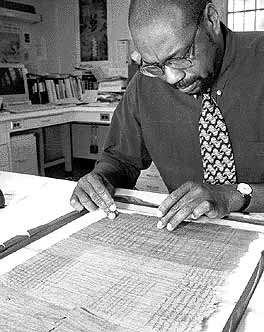Princeton Weekly Bulletin, March 2, 1998
Princeton puts papyri on Internet
A "descriptive inventory" of more than 1,000 ancient Egyptian papyri in the Library's Department of Rare Books and Special Collections is on the Internet as a result of a project funded by the National Endowment for the Humanities (see www.princeton.edu/~dcskemer/papyri.html).
|
|
|
|
|
As Skemer describes it, Princeton's collection of papyri includes several largely complete Books of the Dead, the oldest dating to around 1000 B.C.E. There are significant literary papyri of Homer, Aristophanes, Demosthenes and other Greek authors read in Oxyrhynchus and the Fayum towns of Roman Egypt; and biblical and Early Christian fragments, including a previously unknown monastic letter of the third century. There are horoscopes, amulets, school exercises; official tax registers; and legal and business documents from the Ptolemaic, Roman and Byzantine periods in Egypt. Most of the papyri are in Greek, though there are a number in Demotic, Coptic, Latin and Arabic, as well as a dozen or so Pharaonic texts in hieroglyphic and hieratic scripts.
Brief history of acquisitions
Rosalie Cook "accomplished the principal work of the project," Skemer says, "correcting and updating old descriptions while identifying hundreds of previously uncatalogued Greek fragments never before catalogued." An Australian papyrologist, she was hired with NEH funds and completed her work at Princeton in January.
|
|
|
|
|
As part of the inventory project, all Princeton papyri are being conserved and remounted in the Preservation Office under the supervision of Special Collections conservator Ted Stanley.
The Princeton project is a component of a larger project being conducted by the Advanced Papyrological Information System consortium, which also includes Columbia University, Duke, Michigan, Yale, and the University of California, Berkeley.

